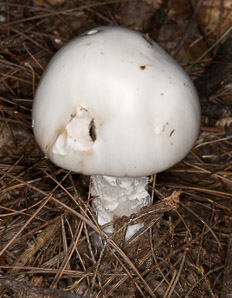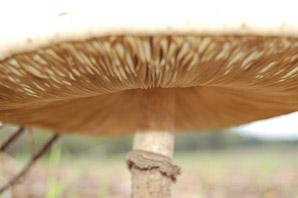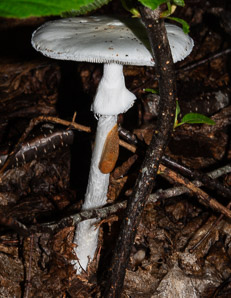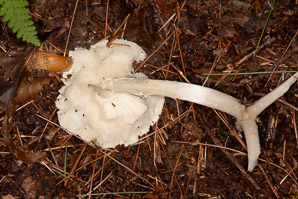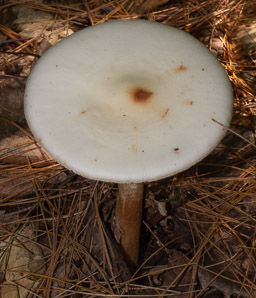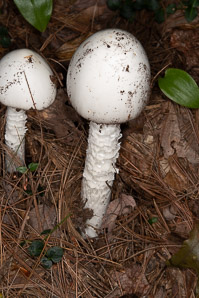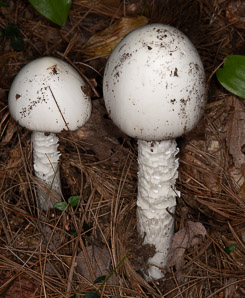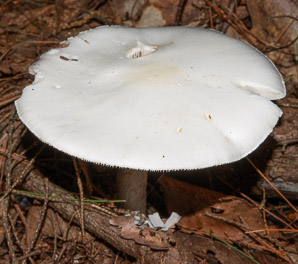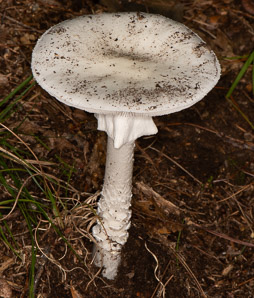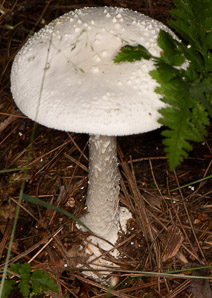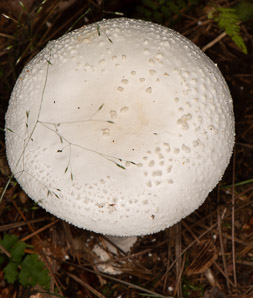
|
Amanita bisporigera Destroying angel, death angel, eastern destroying angel amanita
My mom used to warn us kids about deadly toadstools when we were growing up, and this is the species that best deserves this moniker. It is common and widespread. All members of the Amanita genus are poisonous in varying degrees, but these are perhaps the most dangerous. They appear in mixed coniferous and deciduous forests in eastern North America. Identification: These are usually found singly or in small groups. They are all white, turning a bit tan, straw yellow, or rose pink with age. They rarely have white “warts” on the cap, leftovers of the veil. Fruits are up to 6″ (13 cm) high, with a stipe up to ⅝″ (1.8 cm) in diameter, and a cap up to 4″ (10 cm) in diameter. A thin delicate “skirt” encircles the upper stalk, one identifying feature. Another is that the gills under the cap do not attach to the stipe. The base of the mushroom is a bulblike sac called the volva. A faintly pleasant odor becomes sickeningly sweet/rotten in older specimens. Spores: These typically measure 0.3-0.4 mils () × ~0.3 mils (~). They are globose, ellipsoid, or very rarely elongate. Edibility: Online References:
Michael Kuo's MushroomExpert.com 8/27/2017 · Beaver Brook Conservation Area, Self-guided Nature Trail, Hollis, New Hampshire · ≈ 5 × 8″ (13 × 20 cm) 10/28/2007 · By Jacquelyn Boyt 8/16/2015 · Table Rock Hike, Appalacian Trail, Grafton Notch State Park · ≈ 10 × 15″ (25 × 37 cm) Slugs eat the mushrooms without ill effects. · 9/11/2021 · Otter Brook Preserve, Harpswell, Maine · ≈ 8 × 5″ (20 × 13 cm)
Amanita bisporigera description by Thomas H. Kent, last updated 13 Oct 2021. © FloraFinder.org. All rights reserved. |
7/23/2023 · The Mountain Trails, The Mountain Preserve, Belgrade Lakes Village, Maine 8/28/2017 · Lowell-Dracut-Tyngsboro State Forest, Lowell, Massachusetts · ≈ 6 × 10″ (16 × 24 cm) 8/28/2017 · Lowell-Dracut-Tyngsboro State Forest, Lowell, Massachusetts · ≈ 6 × 10″ (16 × 24 cm) 7/30/2015 · Beaver Brook Conservation Area, Hollis, Massachusetts · ≈ 11 × 7″ (28 × 18 cm) 8/6/2021 · Tarbox Preserve, Topsham, Maine · ≈ 7 × 11″ (18 × 28 cm) 8/15/2021 · Bass Falls Preserve, Alna, Maine · ≈ 6 × 9″ (15 × 22 cm) 8/15/2021 · Bass Falls Preserve, Alna, Maine · ≈ 4½ × 7″ (11 × 17 cm)
|
